Elopak equips fully aseptic filling machine with robust pneumatics.
By Xavier van Aelst, Director Food & Beverage and Christian Broich, Sales Engineer, AVENTICS GmbH, Laatzen, Germany
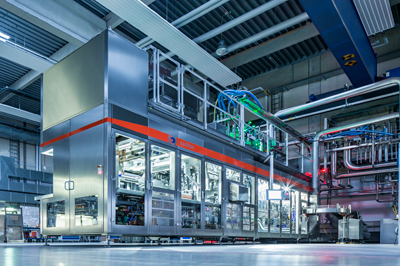
The E-PS120A is the first fully aseptic filling machine for gable-top packaging. Image courtesy of Elopak
Machines for filling consumer-friendly containers with milk or juice have to work around the clock, and disruptions and downtime are not at all welcome. For this reason, availability plays a major role in selecting machine components for Elopak’s E-PS120A, the first fully aseptic filling machine for gable-top packaging. With an output of up to 12,000 cartons an hour, this high-precision, efficient and flexible system ensures high reliability—in part thanks to food-compliant pneumatics from Aventics.
The next-generation E-PS120A platform combines the latest aseptic technology with attractive, convenient Pure-Pak packaging, guaranteeing the integrity of high and low acid products stored at room temperatures for up to one year.
A look at concepts
In developing the E-PS120A, Elopak is pursuing its strategy of highly functional packaging and, in the process, making the company a trendsetter in the area of aseptics. The machine’s new Pure-Pak Advanced filling concept meets both increasing expectations of consumers regarding product design, functionality and quality, and industry and engineering requirements in terms of maximum efficiency and machine availability.
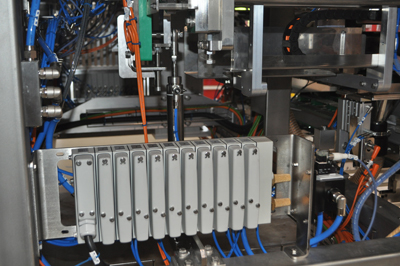
Used in many Elopak machines, the proven HF03 series valve systems will be gradually replaced with the new AV valve series.
The E-PS120A aseptic filling machine relies on the latest automation technology and consists of six modular stations that seamlessly combine to produce a filled carton. First, packaging material gets inserted, recorded, set upright and pre-folded. The sealing cap is then attached and ultrasonically welded, and the bottom prefolded, heated and pressed to seal the carton.
The next chamber sterilizes the packaging with hydrogen peroxide, then the container is precisely filled in a single shot while avoiding splashes or residual liquid on the carton. Finally, the packaging top is induction-welded and transported out of the machine, while any improperly filled cartons are ejected.
With this system, users can choose from three packaging sizes of 500 ml, 750 ml, and 1 l. Because all machine processes are geared to the packaging height, the only adjustment required to switch between them is the height or position of the carton’s bottom. Controlled by a pneumatic cylinder, this movement takes just a few minutes and provides a major advantage compared to competitor machines.
Reliability is key
The design and construction of such a modern filling machine are complex tasks. A sterile environment and aseptic packaging are vital to maintain product quality for the long term at room temperature without cooling the products or using preservatives. This means the ultra-sensitive drinks, dairy products, and liquid foods have to be filled hygienically and securely while machine components are subjected to high strains by cold, humidity, and splashes.
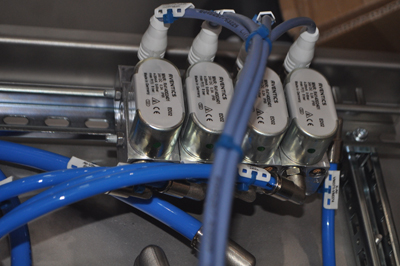
ED02 electropneumatic pressure regulators dynamically control pressure to precisely move the packaging.
Despite the rugged operating conditions the filling machines have to work around the clock. For this reason, availability plays a major role in selecting machine components. According to company engineers, Elopak’s motto is, “Set it then forget it.”
“The latest technical features are not our main concern when selecting components,” stated Wolfgang Buchkremer, Senior Manager for Research & Engineering at Elopak EQS GmbH in Mönchengladbach, Germany. His greatest requirement focuses much more on reliability. “We need components that play their part without standing out—we want to be able to install and then forget them. And that isn’t possible with just any component,”he said.
Elopak owes its success to technical expertise and decades of experience, he continued. “Frequently, permanent reliability comes down to the details,” emphasized Buchkremer, referring to the close collaboration with Aventics. “Even though the pneumatic components installed here at first appear insignificant, they are crucial to machine availability and aseptics. In addition to reliable components, we also need close contact and collaboration with suppliers based on partnerships to detect optimization potentials and drive improvements forward together.”
Tapping pneumatics expertise
Buchkremer cited several pneumatic components as key to reliable and efficient aseptic filling. For example, Aventics SSI Series compact cylinders isolate sealing caps by moving them from one side to another. It sounds like a simple task, but it has to function precisely around one-million times a week in day-to-day operations.
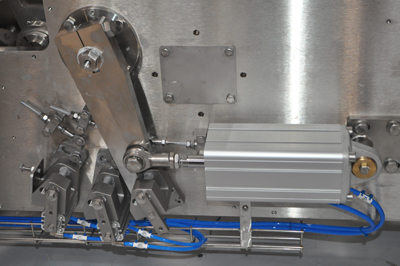
To accommodate different carton sizes, all machine processes are geared to the top height of the packaging. The user simply has to adjust the bottom height using the Aventics CCI compact cylinder to switch products.
Based on concrete application data supplied by Elopak, the Aventics cylinder experts reinforced the piston package—extending cylinder service life—which in turn has a positive effect on machine availability. Other cylinders move packaging forward up to the next processing step. Pressure varies depending on the position and amount of packaging on a rail. Here, the ED02 electropneumatic pressure regulator ensures precise, dynamically controlled pressure, enabling a highly energy-efficient operation.
Another small but critical component is the throttle. Hydrogen peroxide (H2O2) is used to sterilize the packaging, but the substance can have a detrimental effect on all reactive components, including seals and lubricants inside the throttles. Over the long run, choosing the wrong material poses a risk to the entire sterilization process. “We worked with Aventics to find a suitable solution, and now use a throttle that has been cleaned on the inside, with a special sealing ring on the sterilization system’s vaporizer. These design details allow us to achieve higher stability,” stated Johannes Platen, Manager for Engineering and Mechanical Design at Elopak EQS.
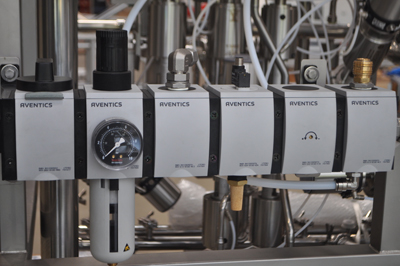
Depending on the application requirement, Elopak combines shut-off and ventilation valves to optimize a compressed-air system’s energy efficiency. Compressed air treatment steps such as filtering, regulating, and dehydrating are integrated in the AS maintenance units to ensure high air quality.
The same concerns hold for valve systems. H2O2-impregnated air also resulted in an application-specific development. To extend the valves’ service lives, engineers at Aventics combined a standard valve system with an aluminum corner strip that included an all-around seal. Now, the valve pilots engage directly in the closed cable conduit within the machine, while the outlets exit the machine. This effectively prevents problematic contact between valves and hydrogen peroxide, contributing to optimized reliability.
Other pneumatic components combine durability with safety and include quick-exhaust and soft-start valves. A special unit on the E-PS120A aseptic filling machine consists of three Aventics components that mainly aim for machine safety to meet the required performance level. Combined with a soft-start and a blocking valve, an AS series maintenance unit offers an array of functions. After a safety cut-out and the system is depressurized, for example by opening the doors, the valve systems are not subjected to the full 6 bars of pressure immediately upon restart. The application-specific design now ensures the valve systems slowly fill with compressed air, helping protect workers and equipment.
Hygienic safety for series production
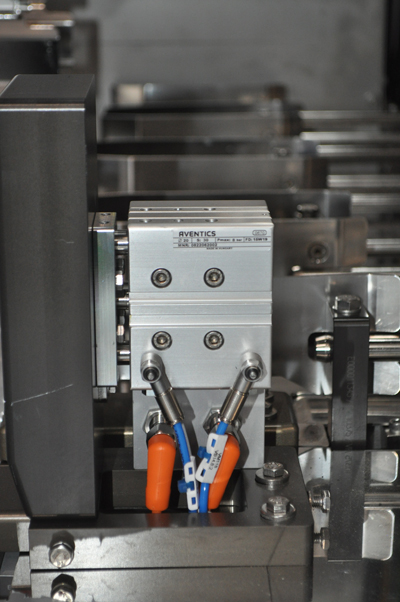
Cylinders in Elopak’s aseptic filling machines must precisely cycle around
one-million times a week.
Aventics pays exacting attention to such details thanks to its many years of experience in designing hygienic components. This is reflected in numerous properties of the ‘best-in-class’ components customized specifically for utmost food safety. In plain terms, this means no recesses or sharp edges, easy cleaning and disinfection, as well as the use of food-compliant materials and lubricants and resistance to chemicals.
“Aventics provided us at Elopak EQS with support right from the start and knows what it means to monitor a near-series machine in development. The pneumatic components made a major contribution in the reliability and low-maintenance requirements of our innovative aseptic filling machine, not least for these reasons. This all boosts machine availability,” emphasized Buchkremer. “Furthermore, Aventics and Elopak support the VDMA initiative to standardize consumption measurement so we are on the same level when it comes to determining energy efficiency, able to implement this together to the user’s advantage.”
Elopak will soon also incorporate the Advanced Valve (AV) series, which is optimized for future requirements for continuous data exchange from the control to the lowest field level. The AV pneumatic directional-control valves are smaller, lighter and more efficient than most similar valves. They include a polymer design and require up to 45% less space than comparable valves.
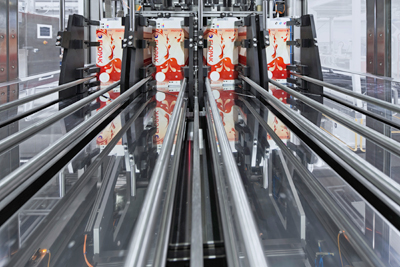
Aventics hygienic components permit easy cleaning and disinfection for the utmost in food safety.
Two sizes are available with flow capacities of up to 300 and 700 lpm, respectively. They can be combined on the same valve manifold, with up to 128 valve coils per manifold. The plug-in design allows for quick valve change-out and, with a 12.5-mm valve slice width, the compact units can be mounted closer to actuators.
Users can quickly configure custom valve manifolds using Aventics online tools. And the related Advanced Electronic System (AES) lets engineers add bus modules, I/O, or electro-pneumatic pressure regulators to a manifold. The AES ensures smooth serial communication between a controller and the AV components.
“This meets our desire to continue driving fieldbus technology forward, also in pneumatics,” says Johannes Platen, adding: “This development, too, will be realized in close collaboration with Aventics.”
Aventics
www.aventics.com/us
Filed Under: Pneumatic Tips, Slider